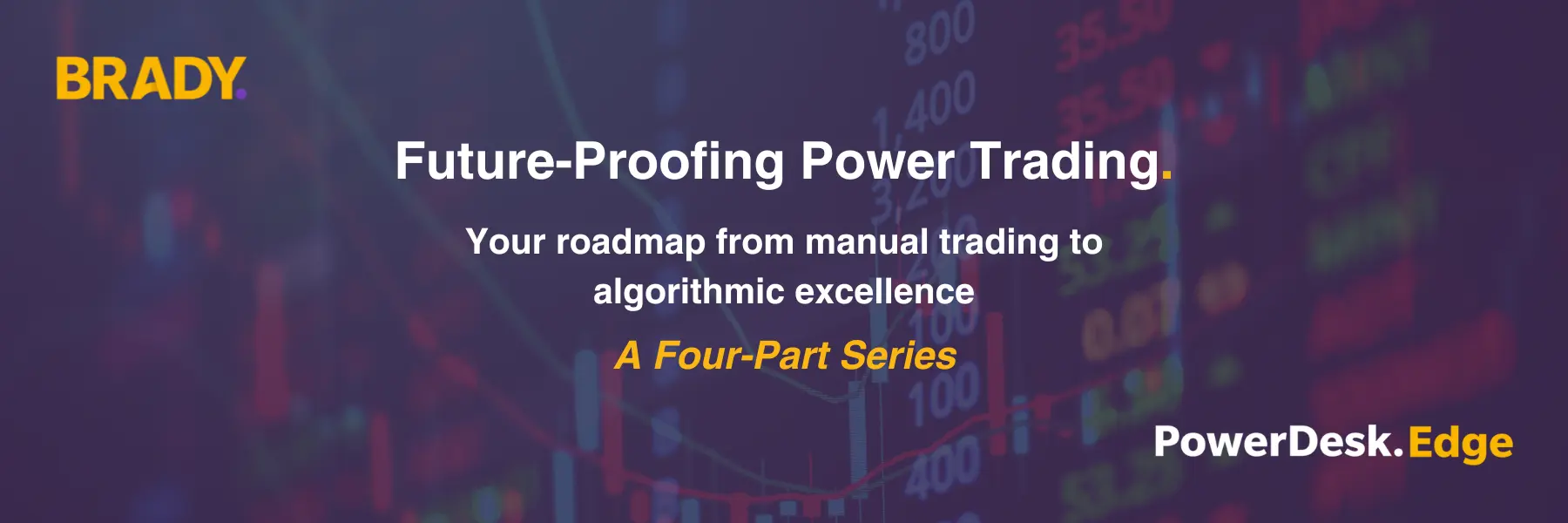A Four-Part Series
Your roadmap from manual trading to algorithmic excellence
The reality check:
Algos now execute 50%+ of intraday power volume on some EPEX markets.
The regulatory factor:
REMIT II explicitly addresses algorithmic trading — effective 8 May 2025
The bottom line:
Whether you’re a wind farm owner paying outsourcing fees or a utility desk with idle data scientists, the market is moving. Fast. And you need a plan to get ahead.
Why This Series, Why Now?
We’ve spent months in the trenches with power traders at every stage of the automation journey; from some clients taking their first tentative steps to hedge funds deploying machine learning strategies. One thing is crystal clear: everyone knows they need to move toward automation, but few know exactly how to get there safely.
This series cuts through the complexity. We’ll show you exactly where you are on the journey, what’s blocking your progress, and, most importantly, how to move forward without triggering compliance alarms or betting the farm.
What You’ll Learn (Episode by Episode)
| Episode | What We’ll Cover | Key Takeaways |
| 1 (Today) | Setting the Stage | • Who’s automating and why • The three-stage journey to algo trading • Where you probably fit in |
| 2 | The Three Personas | • Detailed profiles of market participants • Their specific pain points and opportunities • Why each needs a different approach |
| 3 | The Blockers | • Compliance concerns (and how to address them) • Technical barriers and skill gaps • Market entry challenges for new players |
| 4 | The Playbooks | • Step-by-step implementation guides • Back-testing strategies that convince stakeholders • How to maintain human oversight while scaling automation |
Preview Your Fellow Travelers
Through our work with Brady Power Desk clients, we’ve identified three distinct personas on the automation journey. Which one sounds like you?
Persona 1: The Independent Asset Owner
Profile: Wind farm developer with 2-3 assets, currently paying an offtaker or service provider to handle imbalance trading.
The frustration: “We’re paying fixed fees regardless of performance. When our wind forecast changes at 2am, we have no control over the trading response.”
The opportunity: Take direct ownership of P&L without hiring a 24/7 shift team.
Benefits: → Save on outsourcing fees → Capture the full upside when you trade well → Start simple with overnight rules, refine over time
Persona 2: The Established Utility Desk
Profile: Major players like EDF, BP, or SmartestEnergy with established trading teams and significant market presence.
The frustration: “We have brilliant data scientists chomping at the bit, but compliance sees algos as Skynet waiting to happen.”
The opportunity: Prove value incrementally while maintaining institutional risk standards.
Benefits: → Reduce variance across your 12-person shift team → Create repeatable, auditable trading decisions → Free traders to focus on complex, high-value decisions
Persona 3: The Quantitative Powerhouse
Profile: Hedge funds and prop shops with strong tech capabilities looking to enter UK power markets.
The frustration: “We can build the algos, but UK market entry is complex — BSC parties, credit cover, the works.”
The opportunity: Deploy your existing quant strategies in a volatile, inefficient market.
Benefits: → Use backtesting to demonstrate bounded risk to compliance teams → Reduce variance across your 12-person shift team → Create repeatable, auditable trading decisions → Free traders to focus on complex, high-value decisions
The Three-Stage Journey
Think of automation as a journey, not a destination. Here’s how our clients typically progress:
Stage 1: Backtesting
What it looks like: Test your strategies against historical data before risking a single pound.
See exactly how your rules would have performed across different market conditions.
Who starts here: Everyone should — but especially utility desks who need to convince compliance
Key benefit: Build confidence and prove bounded risk before going live
Stage 2: Rules-Based Trading (RBT)
What it looks like: Simple “if-then” logic. If forecast changes by X MW, trade Y volume. Start with basic rules, refine as you learn.
Who thrives here: Asset owners escaping outsourcing fees, utilities taking first automation steps
Time to value: 3-6 weeks from decision to live trading
Stage 3: Full Algorithmic Trading
What it looks like: Advanced strategies with parameterization, ML-powered signals, complex optimizations, and sub-second execution.
Who pushes here: Quant funds, advanced trading desks, and utilities who’ve proven value with RBT
The edge: When milliseconds saved and high frequency of trades compound into serious P&L
“Think of it like self-checkout at Sainsbury’s. You don’t eliminate humans; you have one person supervising ten automated processes instead of ten people doing manual work. The human oversight is how you get compliance comfortable.”
– Chris Regan, Brady Technologies
The Path Forward
Whether you’re paying too much for third-party trading services, battling compliance concerns, or ready to deploy sophisticated quant strategies, there’s a clear path forward. But each journey is different.
What Happens Next?
Over the next three episodes, we’ll dive deep into:
- Exactly how each persona can capture value through automation
- The specific blockers you’ll face (and how leading firms overcame them)
- Practical playbooks with real examples from the market


